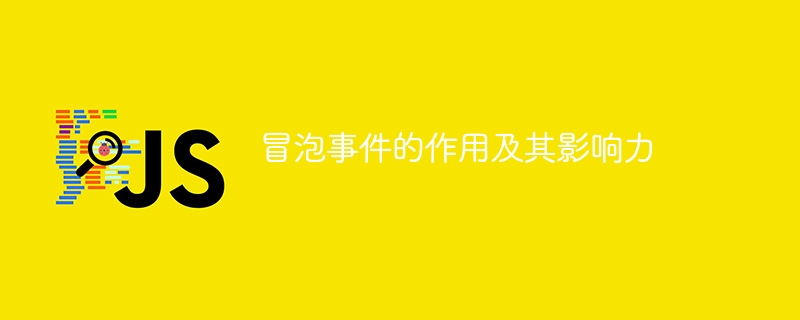Home >Web Front-end >JS Tutorial >The significance and impact of bubbling events
The significance and impact of bubbling events
- WBOYWBOYWBOYWBOYWBOYWBOYWBOYWBOYWBOYWBOYWBOYWBOYWBOriginal
- 2024-01-13 15:15:18915browse

The role and influence of bubbling events
With the development of computer technology, the importance of web applications has gradually increased. In order to provide users with a better user experience, developers use various technologies to enhance the interactivity of web pages. Among them, bubbling events are an important technical means. This article will introduce the role of bubbling events and their impact on web development, and illustrate their specific usage through specific code examples.
Bubbling events refer to an event propagation method that when a specific event occurs on an element, the element's parent elements will be triggered in sequence until the document root node is triggered. Its function is to allow developers to easily perform unified event processing on multiple elements, and to implement functions such as event delegation and dynamic binding.
The feature of bubbling events allows developers to uniformly bind event processing functions to any element without the need to bind independent events to each element. In this way, developers only need to pay attention to the occurrence of the event, and do not need to consider which element specifically triggered the event.
Bubble events have an important influence on web development. First, it simplifies writing and maintaining code. By using bubbling events, developers can use the same event handling function to bind events to multiple elements, reducing the generation of redundant code and improving code reusability and maintainability.
Secondly, bubbling events make dynamic event binding possible. When using the traditional event binding method, if a new element is added, it needs to be independently event bound. The bubbling event can be event-bound on its parent element, and the event handler can be automatically triggered even if a new element is added.
Bubble events can also implement event delegation. Event delegation refers to binding an event to a parent element and capturing the event to bubble up to the element that specifically triggered the event, thereby achieving unified event processing for multiple child elements. In this way, it not only reduces the number of event bindings, but also saves memory usage and improves the efficiency of event processing.
The following uses a specific code example to illustrate the usage of bubbling events:
HTML code:
<div id="parent"> <div class="child">Child 1</div> <div class="child">Child 2</div> <div class="child">Child 3</div> </div>
JavaScript code:
// 获取父元素
var parent = document.getElementById('parent');
// 绑定click事件的处理函数
parent.addEventListener('click', function(event) {
// 获取触发事件的元素
var target = event.target;
// 如果触发事件的是子元素
if (target.classList.contains('child')) {
console.log('点击了子元素:', target.textContent);
}
});In the above code , the click event handler is bound to the parent element. When a child element is clicked, the event will bubble up to the parent element and trigger the event handler. By judging whether the class name of the element that triggers the event is "child", you can determine the specific child element that triggered the event.
The above is a brief introduction to the role and influence of bubbling events. By using bubbling events, developers can simplify code writing and maintenance, and implement functions such as dynamic event binding and event delegation. It brings many conveniences to web development and is one of the indispensable technical means for developers. However, it should be noted that excessive event bubbling may affect performance. Therefore, when using bubbling events, it is necessary to reasonably design the hierarchical relationship of event binding to avoid event propagation too deep and causing performance problems.
The above is the detailed content of The significance and impact of bubbling events. For more information, please follow other related articles on the PHP Chinese website!

